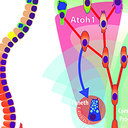[Protective effects of fructose-1,6-diphosphate on brain damage caused by febrile seizures in rats].
Кључне речи
Апстрактан
OBJECTIVE
Febrile seizure (FS) is a pediatric emergency. The reiterative attacks of FS may result in brain damage to various extents. Fructose-1,6-diphosphate, serving as a cellular energy substance, has been applied to clinical practice for many years and has shown its importance in adjuvant treatment of diseases with myocardial damage. This study aimed to explore the potentiality of protecting rats' brain damage caused by febrile seizure with fructose-1,6-diphosphate (FDP).
METHODS
Thirty 21-day-old male Sprague-Dawley (SD) rats were randomly divided into febrile seizure group (FS), sodium chloride solution (NS) control group and FDP intervention group (FD). Febrile seizure was induced by hyperthermal bath at 45 degrees C in the present study. No intervention treatment was given to rats in FS group before febrile seizure. Thirty minutes before febrile seizures, rats in FD group were given peritoneal injection of FDP at a dose of 25 mg per 100 g of body weight, whereas the same volume of 0.9% sodium chloride solution was injected into peritoneum of rats in NS group. Manifestations of seizure and differences in seizure latency, duration of seizure and seizure severity were observed in all the 3 groups. Samples of rat brain were prepared for electron microscopy in order to understand the characteristics of the ultrastructural changes in mitochondria, interspace of neuronal synapses and neurons of hippocampal region CA(1).
RESULTS
Data collected from this study indicated that peritoneal injection of FDP at 25 mg per 100 grams of body weight 30 minutes before febrile seizures could result in improvement of the clinical manifestation of the rats caused by febrile seizures. Specifically speaking, the seizure latency was prolonged, the duration of seizures was shortened and severity of seizure was reduced. Analysis of variance and q-test on the data collected from the 3 groups revealed that there were significant differences between FD group and the other two groups (P < 0.05), yet no significant difference was found between FS group and NS group (P > 0.05). Electron microscopic observations on brain specimens revealed that FDP could relieve mitochondrial degeneration and edema. FDP could also reduce neuronal degeneration and necrosis in hippocampal region CA(1) (the percentages of neuronal degeneration and necrosis in the 3 groups were respectively 13% for FD group, 28% for FS group and 30% for NS group). There was a significant difference between FD group and the other two groups (P < 0.05), FDP treatment could prevent interspace of neuronal synapses from enlarging (the mean interspace was 6.47 +/- 0.37 micro m for FD group, 7.60 +/- 0.36 micro m for FS group and 7.53 +/- 0.40 micro m for NS group. The difference between FD group and the other two groups was significant (P < 0.01).
CONCLUSIONS
FDP could lead to prolonged seizure latency, shorter duration of seizures and mitigation of seizures severity. FDP could also reduce neuronal degeneration and necrosis and prevent the interspace of neuronal synapses from enlarging in hippocampal region CA(1). The present study suggests that FDP can protect brain of rat from damages caused by febrile seizures.



